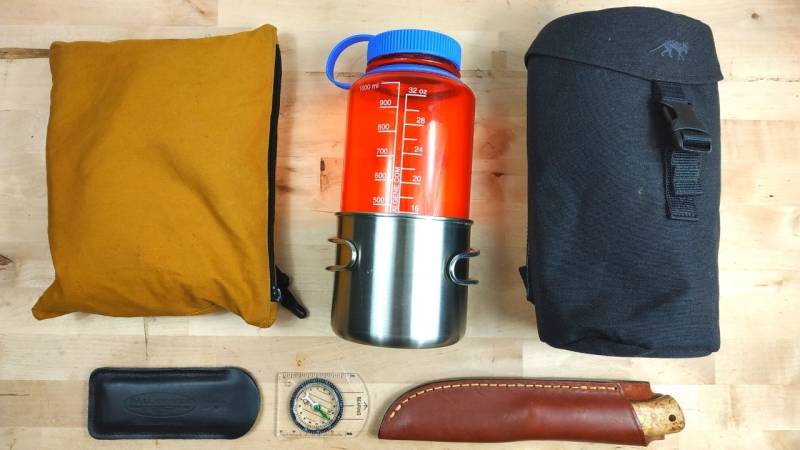
Never forget to take these 7 items into the wilderness (essential wilderness gear)
👉 The key facts from this guide
- A sturdy, sharp knife is an indispensable tool in the wilderness.
- A portable and efficient sharpening stone is important for keeping the knife sharp.
- A Firesteel is a reliable tool for starting a fire.
- A first aid kit is essential for dealing with injuries.
- A metal cup and water bottle are useful for drinking and boiling water.
- A compass is a simple and necessary piece of equipment for navigation.
Imagine being stranded in the middle of nowhere, left to fend for yourself in the wilderness.
Wouldn't it be great if your chances of survival could increase significantly?
Well, it's actually possible with the right items in your survival kit.
And the best part is, there are only a few items that are essential for your survival.
Except for the first item – my knife – the following list of equipment is not sorted by importance. Each item is important and can be more critical in a specific situation or scenario than another.
Let's start with the knife.
Your Knife is your Life
The knife is at the top of my list.
I doubt that surprises you, does it?
There's a lot of discussion when it comes to knives. Some prefer a shorter Bushcraft knife for carving, while others opt for a longer survival knife, which they can use for chopping (here's my top list and buying guide).
Everyone who's interested in Bushcraft, Survival, and the outdoors has their favorite knives.
But all knives should have something in common, and I'm sure you'll agree with me: They should be sharp, sturdy, and safe to use. The blade should be strong, and it should be easy to sharpen in the wilderness.
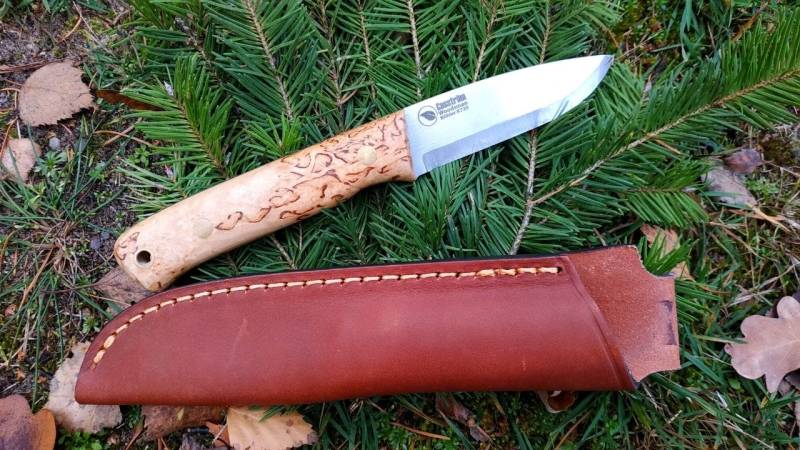
There's a good saying about this:
Your knife is only as good as what you carry with you.
So, never forget your knife.
For me, however, it's more important to know HOW to use a knife than the knife itself.
The more skillful and confident you are with a knife and the more skills you know, the more you will achieve in a shorter amount of time.
In the hands of an expert, a good quality knife is an invaluable tool.
To learn new skills or improve existing ones, I recommend my Knife Basics course, which you can find in the Wildimpuls program (in German). There you will learn how to handle your knife safely, and I will show you all the significant carving techniques as well as knife skills.
Bonus: There's also a matching podcast for this guide. Listen to it here.
Your Sharpening Stone: A Sharp Knife is Safe and Efficient
There are several reasons why it's essential to keep your knife sharp.
- Carving is more enjoyable with a sharp knife.
- You work safely and efficiently with a sharp knife.
Here, I want to dispel the myth that sharp knives are more dangerous than dull ones.
If you work with a dull knife, you have to apply more pressure. This increases the likelihood of slipping or making uncontrolled movements.
The fact is: You make more mistakes with a dull knife. So keep your knife sharp.
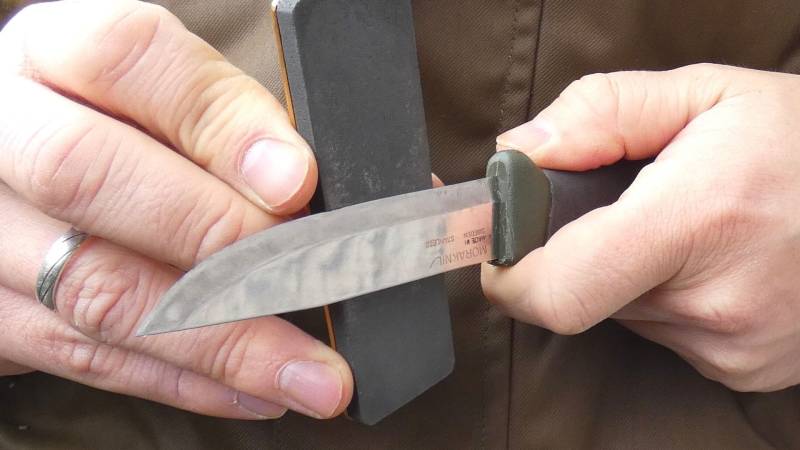
With a portable and efficient sharpening stone, you can easily maintain a sharp edge in the wilderness.
It's best to use a small sharpening stone that can be kept on your body.
I like to use a small and lightweight combination stone.
On one side, it's equipped with fine diamond powder, on the other side with a fine ceramic surface.
Diamond is quite aggressive and quickly removes metal from your blade. Ceramic, on the other hand, removes metal slowly but results in a fine, sharp edge.
The Fallkniven DC4 sharpening stone with its 3.2 x 10 cm size easily fits in your pocket.
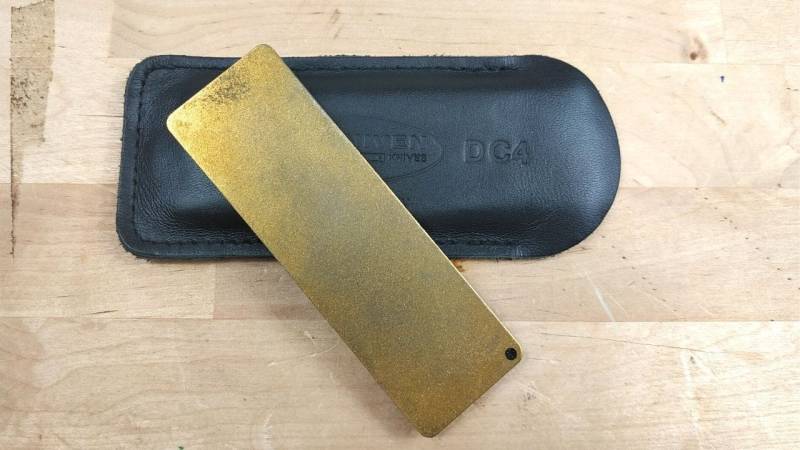
Unlike other sharpening stones, the DC-4 can be used dry. So, you don't have to carry oil or waste water.
Take a look at my article on this: How to keep your knife sharp with the DC-4 sharpening stone.
A fire is crucial
Starting a fire in the wilderness will significantly increase your chances of survival.
You may be familiar with the Swedish Firesteel, also known as a Ferro Rod, Firestarter, or Firestriker.
But to ignite a fire with the firesteel, you must practice this technique (watch here how to do it).
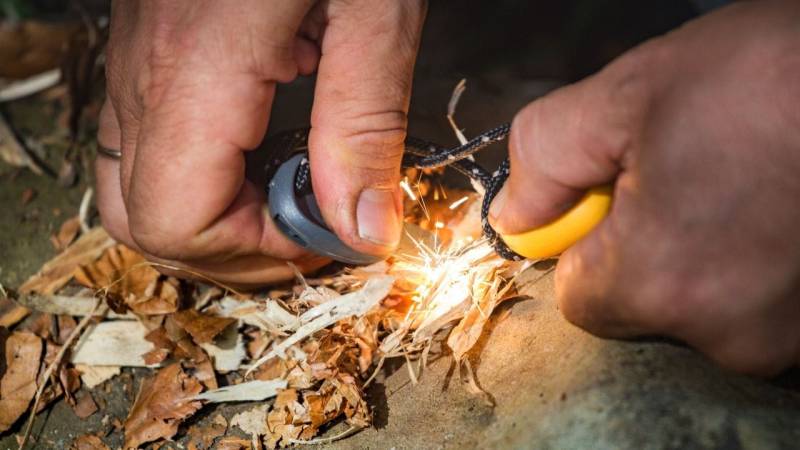
I remember well from my survival training: most participants were unable to ignite a fire with the firesteel.
There was frustration until someone showed them how. And suddenly, they understood how efficient a firesteel can be.
Compared to a box of matches or a lighter, a firesteel produces thousands of ignitions.
In addition, the firesteel can hardly be damaged as it has no moving parts. And it is also waterproof. Even if it corrodes, it is ready for use within seconds.
Therefore, the firesteel should be your first choice when it comes to starting a fire.
There are two important facts you need to remember for the method:
- Use shavings from your firestarter as an accelerator
- Concentrate the sparks on your tinder
I highly recommend my video on this topic. There, you can see how I successfully ignite tinder made from birchbark, fatwood and regular wood using this method.
Even if you can already start a fire with a fire bow, always bring your firestarter as a backup.
Here's my recommendation: Buy a firestarter from "Light My Fire". I prefer the larger "Army" version. However, "Light My Fire Scout" version is just as great.
I always carry my firestarter on my body, either in the pocket of my Bushcraft pants (with cord on the belt) or directly on the belt.
And I removed the extra metal scraper because I use the sharp edge of my knife to scrape.
Book recommendation: If you are keen to learn even more about tinder and making fire, then check out my book "Die Feuer-Fibel".
First aid kit
Whenever I take my (pocket) knife, saw or axe outside, I always pack my first aid kit.
Unfortunately, all too often someone gets injured. And that's when a first aid kit is worth gold.
Cuts need to be cleaned and protected. You don't want an infection.
And just imagine, what if there was a serious injury? Wouldn't it be good if you could take care of it yourself?
That's exactly why I know how to apply a pressure bandage. You need to know this for heavy bleeding.
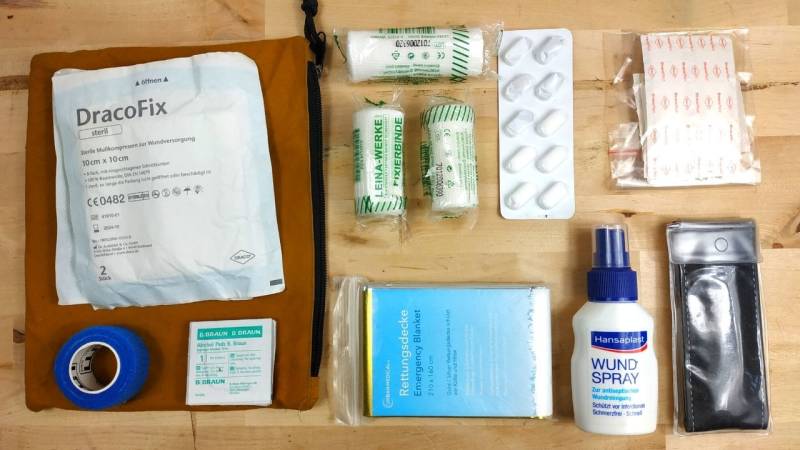
My first aid kit for day trips and up to two overnight stays includes the following:
- Multiple band-aids
- 2x sterile gauze pads
- 1x rescue blanket
- Tick removal tool
- Alcohol swabs
- Wound spray
- 3x elasticated bandages
- Painkillers
- I always have my Mil-Tec Shemagh as a triangular bandage
If you're staying away from civilization for longer, adapt your first aid kit to your length of stay and the region you're in.
I would like to point out that first aid primarily does not mean wound cleaning and detailed care (sewing wounds, etc.). Both tasks are the responsibility of a doctor. First aid means stopping bleeding and covering and treating wounds to prevent bacteria from entering.
I have dedicated an entire guide to this topic. Have a look at my article "Bushcraft first aid kit: put together and apply."
There, you'll also learn how to make a pressure bandage (with video), and I'll give you useful tips that I've noticed over time.
Metal cup and water bottle
Water is vital. And if you know how to find water (check out my water guide), that's half the battle.
Thereafter, you need to make it drinkable, and nothing beats boiling your water.
So, try boiling water without a metal container. It will be difficult, right? Of course, you could do it with hot stones, but it'll be tough.
A metal cup will make your life much easier. Just put it in the fire, and you'll have delicious, clean water.
I prefer an uncoated metal cup.
Uncoated because coated containers are difficult to clean in the wilderness and sometimes result in unpleasant taste combinations.
With uncoated vessels, you can choose between steel (robust), aluminum (light), or titanium (robust and light).
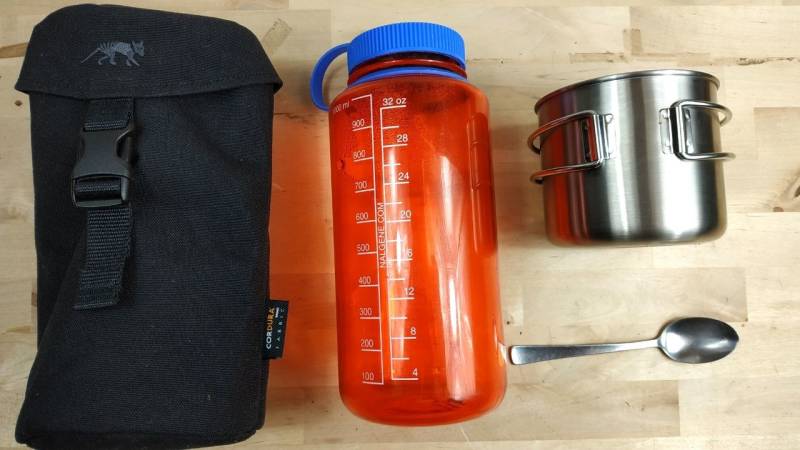
Now you have a metal container, but you can't store your drinking water. Ideally, you should carry at least one liter of water with you. Two liters are better.
Therefore, a great combination solution is offered here: The water bottle fits into the metal cup.
A combination that fits perfectly together, is light, takes up little space and that you can even carry on your body is ingenious.
I've been using the following combo for many years:
- Nalgene Everyday water bottle, 1 liter, in orange, with wide mouth
- Tatonka cup, stainless steel, 150 grams, 500 ml capacity
- Tasmanian Tiger TT Bottle Holder, 1 liter, Molle system
And this is what I mean by "fitting together": The Nalgene bottle fits into the Tatonka cup, and both then fit into the Tasmanian Tiger Bottle Holder.
The good thing is that there is still room in the Tasmanian Tiger Bottle Holder for a spoon, water purification tablet, coffee filter or other small items.
There are certainly more combinations on the market. Just make sure everything fits together well.
P.S. Only buy the Nalgene water bottle with a wide mouth. You can store all sorts of things in their waterproof if needed. Yes, you can even dive at night with it if your flashlight fits into the bottle.
Your compass shows you the way
With a compass, you have a simple yet necessary piece of equipment.
The good thing about a compass is that you don't need batteries, and you can rely on it.
The main purpose of a compass is navigation with a map through unfamiliar areas. (source)
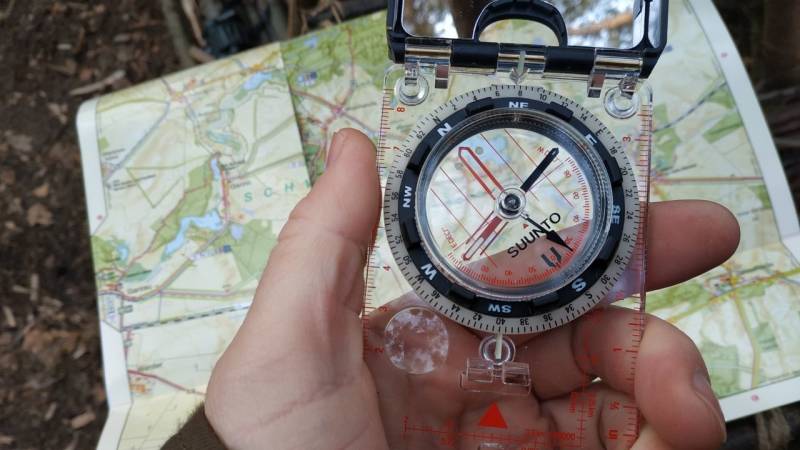
But your compass is not only useful for navigation.
I recommend buying one with a mirror.
You can use it to remove unwanted objects from your eyes, or use the sun's reflection to make yourself visible.
As a starting point, I recommend the Silva Compass Ranger S or the Suunto Compass MC-2/G/6400.
Think about what you really need
It's clear that every piece of equipment is individual.
Maybe you require something different from me, and that's okay. Demands and needs are as diverse as there are people.
What's important is that your equipment should be lightweight and not hinder your progress.
And you should always wear it on your belt. Whether you're just 50 meters from the camp or on a vehicle, airplane, helicopter, canoe, or hiking.
Just imagine slipping by the river and losing your backpack. Or your canoe flips and your backpack goes under.
In the end, your skills count
Survival is not just about collecting equipment.
However, I can fully understand the fun and enjoyment of trying out new tools and testing equipment. I enjoy it myself.
But you should rely more on your skills and techniques.
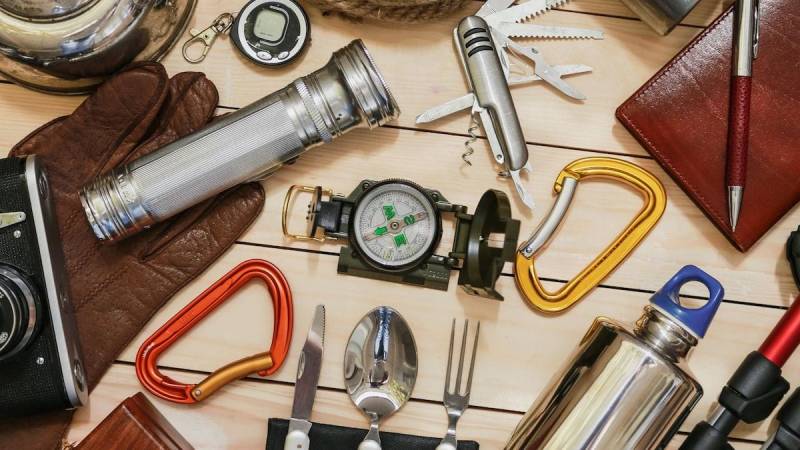
Of course, your equipment makes it easier for you to apply your knowledge and skills.
And the more skillful and experienced you become, the less you have to rely on your items.
Then it's not so bad whether you lose a piece of equipment or it breaks.
Plan your trips
Think carefully about your goals before every journey and outing.
Do you want to get to a destination quickly? Then pay attention to weight. Do you want to stay in one place longer? Then take more tools with you to build your camp from natural materials.
Then think about how you want to meet your needs.
How do you want to make fire? With a firesteel or a bow drill? Where do you want to sleep? In a Bushcraft Shelter, in a hammock, or under a tarp (see my best of list or read my 35 Hacks for tarps)?
For some readers, my equipment might be a nightmare on a 3-day trip. For others, it might be a blessing and pure relaxation.
Or imagine arriving at a deserted island? Then you require other items, as I wrote here.
Every person has different demands and needs.

What are your needs? What does your wilderness equipment look like?
Leave me a comment and let me know what you think of my list.
Even if you agree with my top 7 items, let me and other readers know what's next on your list to create your top 10 list. I'm sure we'll all benefit from it and it'll be an interesting discussion.


Author of the guide
Martin Gebhardt
Hey, I'm Martin. On my blog, you will learn the basics and numerous details about living in the wild. I think survival, bushcraft and the good life in nature are the keys to happiness. Find me here on Instagram or on YouTube. You can find more about my mission on the About Me page.
Was this guide helpful?
26 people found this guide helpful.
5.00 out of 5 points (26 Ratings)
Comments (0)
This post may contain affiliate links. So if you click on the links and make a purchase, I will receive a small commission at no additional cost to you. Click here, to learn more about it.


